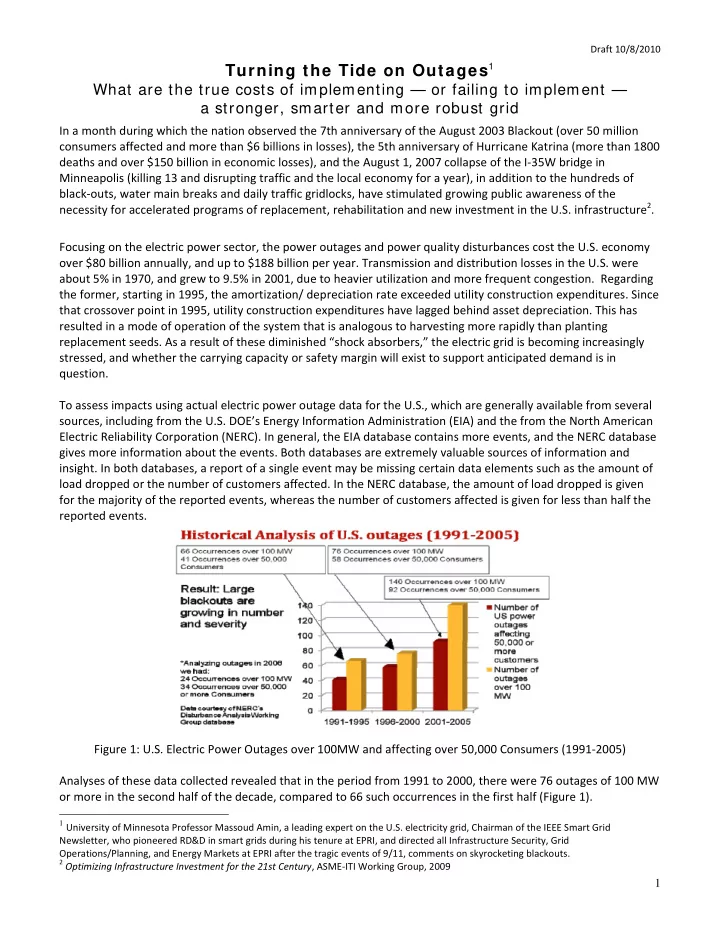

Draft 10/8/2010 Turning the Tide on Outages 1 What are the true costs of implementing — or failing to implement — a stronger, smarter and more robust grid In a month during which the nation observed the 7th anniversary of the August 2003 Blackout (over 50 million consumers affected and more than $6 billions in losses), the 5th anniversary of Hurricane Katrina (more than 1800 deaths and over $150 billion in economic losses), and the August 1, 2007 collapse of the I ‐ 35W bridge in Minneapolis (killing 13 and disrupting traffic and the local economy for a year), in addition to the hundreds of black ‐ outs, water main breaks and daily traffic gridlocks, have stimulated growing public awareness of the necessity for accelerated programs of replacement, rehabilitation and new investment in the U.S. infrastructure 2 . Focusing on the electric power sector, the power outages and power quality disturbances cost the U.S. economy over $80 billion annually, and up to $188 billion per year. Transmission and distribution losses in the U.S. were about 5% in 1970, and grew to 9.5% in 2001, due to heavier utilization and more frequent congestion. Regarding the former, starting in 1995, the amortization/ depreciation rate exceeded utility construction expenditures. Since that crossover point in 1995, utility construction expenditures have lagged behind asset depreciation. This has resulted in a mode of operation of the system that is analogous to harvesting more rapidly than planting replacement seeds. As a result of these diminished “shock absorbers,” the electric grid is becoming increasingly stressed, and whether the carrying capacity or safety margin will exist to support anticipated demand is in question. To assess impacts using actual electric power outage data for the U.S., which are generally available from several sources, including from the U.S. DOE’s Energy Information Administration (EIA) and the from the North American Electric Reliability Corporation (NERC). In general, the EIA database contains more events, and the NERC database gives more information about the events. Both databases are extremely valuable sources of information and insight. In both databases, a report of a single event may be missing certain data elements such as the amount of load dropped or the number of customers affected. In the NERC database, the amount of load dropped is given for the majority of the reported events, whereas the number of customers affected is given for less than half the reported events. Figure 1: U.S. Electric Power Outages over 100MW and affecting over 50,000 Consumers (1991 ‐ 2005) Analyses of these data collected revealed that in the period from 1991 to 2000, there were 76 outages of 100 MW or more in the second half of the decade, compared to 66 such occurrences in the first half (Figure 1). 1 University of Minnesota Professor Massoud Amin, a leading expert on the U.S. electricity grid, Chairman of the IEEE Smart Grid Newsletter, who pioneered RD&D in smart grids during his tenure at EPRI, and directed all Infrastructure Security, Grid Operations/Planning, and Energy Markets at EPRI after the tragic events of 9/11, comments on skyrocketing blackouts. 2 Optimizing Infrastructure Investment for the 21st Century , ASME ‐ ITI Working Group, 2009 1
Draft 10/8/2010 Furthermore, there were 41% more outages affecting 50,000 or more consumers in the second half of the 1990s than in the first half (58 outages in 1996–2000 versus 41 outages in 1991–1995). In addition, between 1996 and 2000, outages affected 15% more consumers than they did between 1991 and 1995 (the average size per event was 409,854 customers affected in the second half of the decade versus 355,204 in the first half of the decade). Similar results were determined for a multitude of additional statistics such as the kilowatt magnitude of the outage, average load lost, etc. These trends have persisted in this decade. NERC data show that during 2001 ‐ 2005 we had 140 occurrences of over 100 MW dropped, and 92 occurrences of over 50,000 or more consumers affected. Historical Analysis of U.S. Outages (2001 ‐ 2010) 350 300 Number of US power outages affecting 50,000 or more customers 250 Number of Outages 200 Number of outages of 100 MW or more 150 100 50 0 2001 ‐ 2005 2006 ‐ May 2010 Figure 2: U.S. Electric Power Outages over 100MW and affecting over 50,000 Consumers during 2001 ‐ 2010 through May 2010 (EIA data) Figure 2 provides a summary of the outages 3 in the most recent decade: There were 200 outages of 100 MW or more during 2001 ‐ 2005; such outages have increased to 219 during 2006 ‐ May 2010. The number of U.S. power outages affecting 50,000 or more consumers increased from 197 (during 2001 ‐ 2005) to 312 (during 2006 ‐ May 2010). Historical Analysis of U.S. Outages (2001 ‐ 2010) (Adjusted for 2%/year increase in load to 2001 levels) 300 Number of US power 250 outages affecting 50,000 or more customers Number of Outages 200 Number of outages of 100 150 MW or more 100 50 0 2001 ‐ 2005 2006 ‐ May 2010 Figure 3: U.S. Electric Power Outages over 100MW and affecting over 50,000 Consumers during 2001 ‐ 2010 through May 2010 (EIA data), adjusted for 2% load increase per year Adjusting for 2% per year increase in load to 2001 levels (Figure 3), the above outages reflect the following trend: 3 Research is supported by a grant from the NSF. For preparations of Figures 2 ‐ 3, I gratefully acknowledge Mr. Anthony Giacomoni, my Graduate Research Assistant, in the department of Electrical & Computer Engineering at the University of Minnesota ‐ Twin Cities. 2
Recommend
More recommend